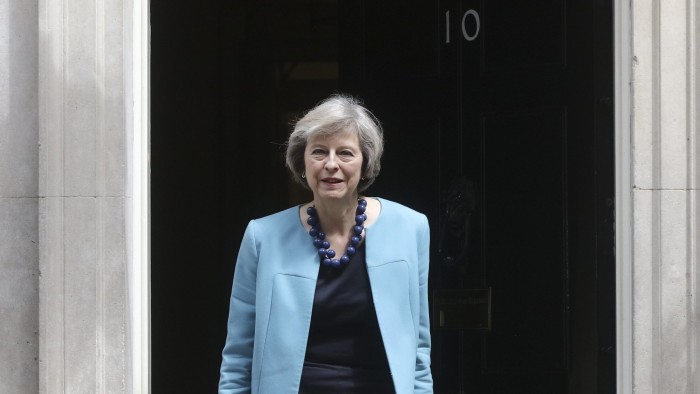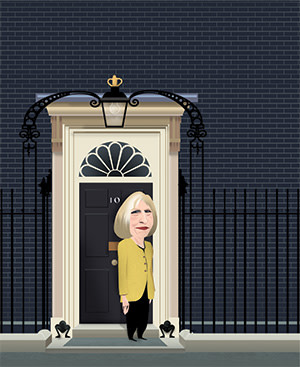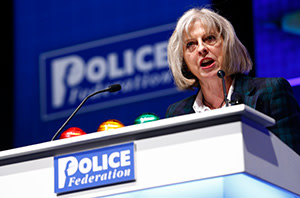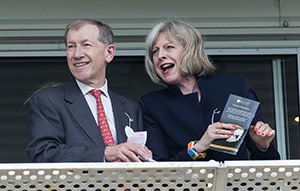Theresa May: Britain’s Angela Merkel?

Simply sign up to the Life & Arts myFT Digest -- delivered directly to your inbox.
It was billed as “the march of the women” but David Cameron decided well before this month’s ministerial reshuffle that one woman in his cabinet was going nowhere: Theresa May.
After two remarkable months in which the home secretary has added an unpredictable ruthlessness to her political armoury, the prime minister and his allies are both respectful and wary of May, the most powerful Conservative woman since Margaret Thatcher. “One of the central principles of the reshuffle was that Theresa must not be promoted,” says one official close to Cameron.
Theresa May this month became Britain’s longest-serving home secretary in more than 50 years, establishing a reputation for cool competence that has won her admirers across the party and made her the bookmakers’ favourite to succeed Cameron as Tory leader.

Her success makes her an intriguing figure at the top of his government: too popular with Tory activists to demote, too dangerous to promote. When May publicly clashed with education secretary Michael Gove in June in a row over Islamist infiltration of Birmingham schools, Cameron was furious with both ministers. But as one Downing Street insider confessed at the time: “Theresa is untouchable.” A month later, it was Gove – one of Cameron’s best friends – not May who lost his cabinet post in the reshuffle.
Cameron admires May’s record at the Home Office but they are not close. Downing Street has long suspected her of being “on manoeuvres” for the Conservative leadership, her activities tracked assiduously, her ambitions seen as a direct threat to Chancellor George Osborne, whom Cameron hopes will one day succeed him. So when William Hague stepped down as foreign secretary in the reshuffle, Cameron did not promote May to the Foreign Office but installed instead the technocratic defence secretary Philip Hammond. One minister close to Hammond said: “Philip is worried he’s being used by Cameron.”
The minister added that Hammond feared he might end up simply keeping the seat warm for Osborne – thought to favour a move to the Foreign Office if the Tories win next year’s election – and was being deployed by Cameron “as a block on Theresa May”.
But what have they got to worry about? In the 21st century, could Theresa May, a politician who appears austere and remote, shuns the media and refuses to put her private side on show, ever rise to the highest level? Tory activists apparently think so: a leadership survey by the ConservativeHome website in June found that May was the choice of 35 per cent of respondents, more popular than the ebullient London mayor Boris Johnson and far more popular than Osborne.
One Tory cabinet minister close to Cameron summed up in three words the sniffy but watchful view of May of some at the top: “Dull, boring, ambitious”. But at Westminster a reappraisal is now under way, triggered by May’s “don’t mess with me” handling of the row with Gove and a remarkable speech on police reform, delivered just a few weeks earlier.
Those who know her well say only the slight crack in her voice at the end of her Police Federation speech in Bournemouth betrayed the tension of the moment, but May was relentless. Standing in front of a hall full of mainly male police officers, Britain’s home secretary fixed her audience with a piercing stare as she painstakingly listed the corruption, incompetence, racism and gross misconduct that had scarred policing for more than 20 years. In the past she had been jeered and booed by the Police Federation but this time the reaction was different: silence.
“I think it was shock; it was like an icy chill descended on the hall,” Sir David Normington, a senior civil servant and adviser on police reform, recalls. “There was almost a wildness about her,” remembers Ian Pointon, chairman of the Kent Police Federation. Brian Reade, in the usually hostile Daily Mirror, called it “one of the bravest, most astonishing political speeches for years – she obliterated them.” For Tim Montgomerie, a Conservative commentator, the speech in May this year was the home secretary’s “reveal” moment. The most common adjective used by MPs across party lines was “magnificent”. People knew she could be tough but not that tough; Theresa May had a new steely edge and suddenly people were not quite sure what she would do with it.
After the dramas of the past few weeks, May has reverted to her default political setting. The home secretary’s style is as determinedly no-nonsense and clinical as her bob haircut. Earlier this month she was asked by Keith Vaz, Labour chairman of the Commons home affairs committee, if she would celebrate becoming the longest-serving home secretary since Rab Butler in 1962. “No, I am not somebody who celebrates those sorts of things,” she replied with deadly seriousness. “Frankly, I just get on with the job.”
…

Theresa Mary May, née Brasier, was born in 1956 and is one of just two Conservative women to rise this far in British politics. Margaret Thatcher is the only other Tory woman to have occupied one of the four “great offices of state”: prime minister, foreign secretary, chancellor, home secretary. But a more relevant comparison is made between May and Angela Merkel, the German chancellor: another non-ideological politician with a ruthless streak who gets on with the job. “If you think of what she’s achieved, you know, there are still people who don’t rate her, are a bit dismissive, perhaps because of the way she looks and dresses,” May said of Merkel in 2012 in a rare personal interview with The Daily Telegraph. “What matters is, what has she actually done?”
Like Merkel, May is the daughter of a Protestant clergyman. She grew up in a household where public service and an adherence to the Conservative faith went hand-in-hand. A self-confessed “goody two shoes” at school in Oxfordshire, she attended a Roman Catholic private school and a state comprehensive before heading up the road to Oxford university to study geography. Her father, the Rev Hubert Brasier, died in a car crash when she was in her mid-twenties but his influence and her mother Zaidee’s Conservative affiliations shaped her; by the age of 12 she knew she wanted to be a Tory politician and her Christian faith remains strong. By the time she arrived at Oxford, her friends say the young Theresa Brasier was much the same woman one sees today. “There was no wild side,” says one friend ruefully.
She was introduced to her future husband Philip May by Benazir Bhutto – a contemporary who went on to be prime minister of Pakistan – at a Tory student disco and thus started what her friends say is a rock-solid relationship which has underpinned her political career. Philip was a skilled debater and said to have harboured his own political ambitions but friends say he is a devoted champion of his wife. “He’s supportive but not competitive,” says her friend Catherine Meyer, charity CEO and wife of Sir Christopher Meyer, former US ambassador. “He’s reserved, kind, polite. He’s also a bit shy.”
While Theresa May went on to hold staff jobs at the Bank of England, Philip became a successful investment banker and now works at Capital International. He remains in the background but they are inseparable, sharing an interest in food and – like Angela Merkel – a passion for Alpine hiking. As with the German chancellor, Theresa May has not had children. “It just didn’t happen,” she said in 2012, offering a rare glimpse of an inner sadness: “You look at families all the time and you see there is something there that you don’t have.”

May became an MP in 1997 for the seat of Maidenhead, a solid Tory swath of Berkshire including the Thameside village of Sonning, where she lives and is a regular churchgoer. Within five years she had risen to become the first female chairman of the party, where she came to national attention by making another breathtaking speech. To the extent that May’s political credo is evident, she is a liberal Conservative, supportive of gender equality, champion of female representation at Westminster and a backer of gay marriage (although previously opposed to gay adoption). When she addressed the Tory conference in the dark days of opposition in 2002, she confronted her mainly elderly and rightwing audience with the assertion that many voters considered them to be “the nasty party”.
“Twice we went to the country unchanged, unrepentant, just plain unattractive,” she told the party. “Twice we got slaughtered,” she added. The days of the Tories hankering after “some mythical place called Middle England” were over.
It was the first glimpse of May’s willingness to take bold political positions. But colleagues say she never acts without first conducting a thorough risk assessment, working through the possible outcomes, making sure she will come out on top. “She’s very good at seizing the moment,” says one confidant. The “nasty party” speech also showed she had the capacity to connect with voters. Andrew Cooper of the pollsters Populus says: “We were doing focus groups at the time and people watching Theresa May’s speech on fast-forward said spontaneously, ‘Stop the tape.’ They were gripped by it.”
May’s colleagues say that she has a “six-month rule” that she keeps her head down for long stretches before making a decisive intervention roughly twice a year. But during the long years of opposition from 1997 until 2010, when May held a series of shadow ministerial posts, she barely registered in the public consciousness at all apart from for her “nasty party” speech and – of all things – her shoes.
…

Those who worked with May during her pre-politics days do not remember her showing any flair for footwear but ever since that 2002 conference speech where she sported a pair of leopard-print kitten heels her shoes have become one of the few hints that she might have a flamboyant side waiting to be unleashed. According to the Commons register of interests, Russell & Bromley, the shoe chain, thanked her for attracting bumper sales of its leopard heels in 2002 by giving her “three pairs of Hot2Trot shoes” from its new line; the register also shows that since becoming home secretary she has received discount cards from high-street brands LK Bennett, Amanda Wakeley and Hobbs.
May does not seem offended by coverage of her sartorial choices. When she and a Burberry model were both pictured in the Daily Mail wearing the same Vivienne Westwood suit, under the headline: “Is Theresa May the new Cara Delevingne?”, May drew attention to the comparison, joking: “I think we can safely say that the answer to that … is no.” Her shoes are a rare conversational icebreaker – often the only smalltalk entertained by May.
Catherine Meyer says that her friend is a “serious woman” but she insists there is another side to her: “She enjoys going out with friends, to restaurants, people’s houses. She talks about holidays, clothes. She’s quite girly in that sense.” Aside from fashion, there is one other insight into May’s private life to suggest that she may have a more carefree side: she enjoys cooking but says she is a fan of Jamie “chuck it all in” Oliver and cannot stand the culinary precision of Delia Smith.

Last year there was much interest in her sudden weight loss, variously attributed to a diet, stress, a thrice-weekly visit to the gym or an image overhaul ahead of a leadership bid. It turned out to be none of the above. She discovered to her “shock” that she was suffering from Type 1 diabetes, requiring her to inject herself with insulin twice daily. “It’s a case of head down and getting on with it,” she said.
For four years at the Home Office May has eschewed publicity (her media strategy is essentially to have no media strategy, aside from a few well-placed briefings to the rightwing press). Unlike Cameron and Osborne, she regards Twitter as a waste of time. Her political style is similar to that of her cricketing hero Geoffrey Boycott, an England batsman whose priority was the occupation of the crease, fastidiously accumulating runs at a snail’s pace and breaking down the opposition through his sheer determination not to make a mistake.
May admires all that in Boycott. But there were other aspects to Boycott’s career which May’s critics also see in her: he was a loner, not a team player. His quest for perfection bordered on obsession. In a comment that might have applied to May, the sports journalist Ian Wooldridge once commented: “Boycott, in short, walks alone.”
May likes to work through problems herself, aided by an inner core of officials and special advisers, going through documents until the early hours before coming to a decision. “Distrustful is not quite the right word, but she is very, very wary about other people – about other people trying to impose their view on her,” according to one close colleague. “She’s a bit of a loner. She believes that she’s in control of her own area and that’s her own business.” Philip Augar, a former equities broker and ex-Home Office non-executive director, says: “She is receptive to challenge, she doesn’t leap down your throat. She likes to be told the truth but there’s a caveat: you have to know what you’re talking about.”
However, Pauline (Lady) Neville-Jones, the former security minister, left the Home Office after a year because she could not stand working with May, telling colleagues that her former boss was simply unable to delegate. Nick Herbert, former policing minister, recently described his boss as a “fierce” leader with a tendency to micromanage.

May exerts control over her unwieldy department through her political advisers, who filter out advice, defend her interests and bawl out officials who screw up. The pugnacious Fiona Cunningham, who defended May against attacks from fellow Tory ministers, resigned last month in the wake of the Gove spat but she retains Nick Timothy, who provides her with a political edge. “It’s very hard to square this calm, cool, thoughtful, reserved, enigmatic person with these incredibly tribal special advisers,” says one Home Office insider. “It’s like an alter ego really. They play a role that she doesn’t play or can’t play.”
Meetings with May start promptly without preamble. “She may sit in silence for some time and the danger is you end up babbling away,” says one official. She does not lose her temper but prefers the power of an icy glare. “She’ll say, ‘This isn’t going to happen again,’ says one official. ‘Then she’ll let silence fill the room.’”
That May has survived four years in the Home Office is down in some part to “good luck”, according to one close colleague, especially as she is having to enforce security, tackle crime and control immigration while implementing a 20 per cent budget reduction; her attempts to fight off Osborne over cuts failed. But her record is also one of dogged determination and some bold interventions. She eventually succeeded in deporting the radical preacher Abu Qatada after years of legal appeals and she won plaudits from Tory colleagues for refusing to extradite Gary McKinnon, who hacked Pentagon computers, on the grounds that he had Asperger’s syndrome; the White House was furious but the Daily Mail cheered. The economic recession was not accompanied by a crime wave; there has been no major domestic terrorist incident on her watch.
Keith Vaz said this month that recent events at the Home Office had been “somewhat shambolic” – including May’s confused handling of an inquiry into alleged paedophilia at Westminster. There have been other problems, including chaos at the Passport Office, the secret relaxation of border controls, the 2011 riots and the failure to meet the government’s target of cutting annual migration to the UK to the “tens of thousands”. But May has proved that if you do not court the media when things are going well, you are a less of a target when things go wrong. Rather than responding to bad news with a barrage of media interviews, May gives a no-nonsense statement to the House of Commons and retreats to her office.
May’s attempts to meet the immigration target have infuriated business leaders and fellow cabinet ministers, who argue that bureaucracy around visas is cutting off a vital flow of talent and tourists to Britain. Osborne, Jeremy Hunt, the health secretary, and Vince Cable, the business secretary, are among those who have tried and failed to get her to budge. “She just sits there in cabinet looking exasperated in a poised way,” says one cabinet minister. Even when May appears to have agreed some modest concession on immigration, colleagues note that months later nothing has actually changed.
May’s stance on immigration appeals to the Tory right, but this apparent deviation from her normally liberal stance is driven by her belief that uncontrolled immigration has fuelled the rise of populist, rightwing parties. “Sometimes I think only Theresa and I actually believe in our immigration policy,” Cameron once moaned in cabinet. Even if they are not close, Cameron admires the way his home secretary has managed her department, securing his flank in the sensitive area of security and law and order.
…
While tough on immigration, May has struck liberal positions in areas such as scrapping Labour’s plans for ID cards and reforming police stop and search powers. But her reputation as a moderniser is not a central part of her political persona. As with Merkel, ideology is not May’s thing. “She is a person who really believes that their function in life is to make things better, neater, more organised and just a bit more effective than they used to be,” says a former colleague.

When May did give a speech last year setting out a wider vision outside her brief – featuring rightwing ideas such as profitmaking public services and the leftish notion of an industrial policy – it was seen as such a rare intervention that Cameron immediately interpreted it as a leadership move. Michael Gove, a friend of Cameron’s, lambasted colleagues at a cabinet meeting for a lack of loyalty to the prime minister, adding: “I’m talking here particularly about Theresa May.” One minister recalls: “Our jaws hit the floor but Theresa’s expression didn’t change.”
She might be a political blank sheet but May is the bookmakers’ 4/1 favourite to succeed Cameron, ahead of Boris Johnson. While Johnson paints on a broad canvas, May offers to join up the dots. But if she is to seize the crown, May knows she has to build her base in the House of Commons. Downing Street has clocked the fact that she is stepping up her contact with MPs, including launching a series of “meet Theresa” surgeries in the Commons tea room and working the “rubber chicken circuit” of constituency dinners. May’s contacts with journalists are also increasing: this month she drank wine with female lobby correspondents in the press bar, jokingly wagging a finger at any male journalist with the temerity to enter the room.
“The question is whether she’ll get out of the Commons,” says one cabinet minister, noting that it is MPs who decide which two candidates are put to the party membership in a leadership contest. Osborne has control of the party machine and Tory MPs note that May has no “troops”, beyond a handful of former women ministers, and needs to reach out to the right. But one says: “That’s not insurmountable: people will back her if she looks like a winner.”
Certainly she is respected by her political opponents. “She’s a real grown-up, very, very impressive – she’s the one,” says one member of the Labour opposition top team. Keith Vaz says: “She reminds me a lot of Angela Merkel. Angela Merkel was in the beginning thought of as quite boring, and now everyone is saying what a great gal she is.”
Is May preparing for a leadership bid if the Tories lose the 2015 general election? Cameron, Osborne and Johnson will be watching her every move, hoping for some clue to her intentions, her plan. One cabinet minister close to Cameron says: “I admire her but one day she will have to let us know who she is.” Or will she?
George Parker is the FT’s political editor and Helen Warrell is public policy correspondent
Illustration by Luis Grañena
Photographs: Getty; Reuters; Rex Features
Comments